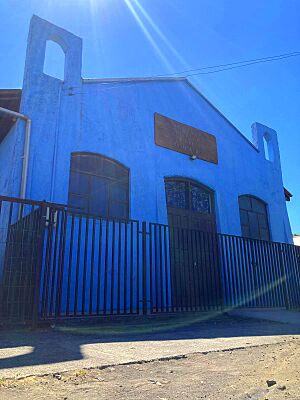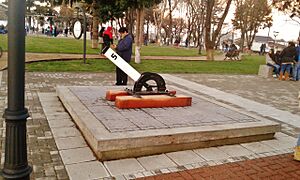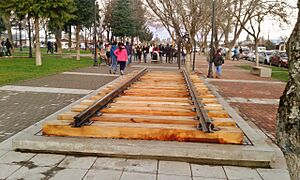Monte Águila facts for kids
Quick facts for kids
Monte Águila
Monteaguila
Monte-Águila |
|
|---|---|

Monte Águila Main Square
|
|
| <mapframe latitude="-27.839076" longitude="-69.960938" zoom="3" width="260" height="200" align="right">
{ "type": "FeatureCollection", "features": [ { "type": "Feature", "properties": {}, "geometry": { "type": "Point", "coordinates": [ -72.4399, -37.0803 ] } } ] } </mapframe>Location in Chile.
|
|
| Country | Chile |
| Region | Bío Bío |
| Province | Bío Bío |
| Commune | Cabrero |
| Government | |
| • Type | City belonging to Cabrero. |
| Population | |
| • Total | 6,574 |
| Time zone | UTC−4 (CLT) |
| • Summer (DST) | UTC−3 (CLST) |
| Area code(s) | 56 + 43 |
Monte Águila is a city in Chile, located in the Bio Bio area. Its name means "Mount Eagle" in English. About 6,574 people live there.
Contents
- What's in a Name? The Meaning of Monte Águila
- A Look Back: The History of Monte Águila
- Where is Monte Águila? Geography and Nature
- Who Lives Here? Population and People
- Faith and Beliefs: Religion in Monte Águila
- Learning and Schools: Education in Monte Águila
- Fun and Traditions: Culture and Society
- Sports and Recreation
- Staying Connected: Media in Monte Águila
- Gallery
- See also
What's in a Name? The Meaning of Monte Águila
The name "Monte Águila" comes from the Mapudungun word for "Mount of the Eagles." This name was given by a Mapuche leader named Ñancomawida. He was an important figure in the area a long time ago.
A Look Back: The History of Monte Águila
Early Days and First Settlers
Monte Águila has a history of about 150 years. The first people to live here were the Mapuche and Araucanian groups. They were known as Coyunches, meaning "People of the Sands." Their leader was Ñancomawida.
In 1852, the Mapuche people had to leave their lands. This happened because of new laws from the Chilean government. German immigrants then started to settle in the area. The Mapuche tried to get their lands back in the 1880s.
The Railway Era and Growth
A big change for Monte Águila was the building of the state railway in 1864. After a war in 1880, the town became a key place for moving supplies. In 1887, a trade route opened between Monte Águila and Neuquén in Argentina. This helped the city grow a lot until 1968.
Another important railway was built in 1905, connecting Monte Águila to the Polcura River. This railway helped the city develop quickly. It brought new people and new ideas to the area.
Monte Águila Today
Monte Águila is still growing today. In 2002, it had 6,090 people. Many residents work as farmers or in nearby cities like Los Angeles and Concepción. The old railway is not used much anymore. Its buildings are empty because the railway company owns them.
However, the city has built new shops and fun places. The main square was recently made new and looks great.
Where is Monte Águila? Geography and Nature
Monte Águila is in a flat area called the Intermediate Depression. It is about 19.67 kilometers (12 miles) from the border of the Ñuble and Biobío regions. The town is 115 meters (377 feet) above sea level.
Earthquakes and Weather
Chile is in an area called the Ring of Fire. This means it often has earthquakes. Monte Águila was affected by big earthquakes in 1960 and 2010. Other natural events have also happened, like a tornado in 2019 and heavy floods.
The town has a Mediterranean climate. This means it has clear seasons with both dry and rainy periods.
Who Lives Here? Population and People
In 1907, Monte Águila had 91 people. The railway and farming helped the town grow fast. By the 1930s, almost a thousand people lived here. This number doubled in the next 30 years. In 1992, there were 5,207 people, and in 2002, it reached 6,090.
The people of Monte Águila live in different neighborhoods called "villas." The "11 de septiembre" villa is the largest. The city was planned in a grid shape, starting from the railway station.
Faith and Beliefs: Religion in Monte Águila
Many people in the Biobío Region are Catholic Christians or Protestant Christians. There are also smaller groups of Jehovah's Witnesses. Some people do not follow any religion.
Monte Águila has a Catholic church called "Nuestra Señora del Carmen" Chapel. It was built in the late 1800s. There are also several Protestant Christian churches in the city.
Learning and Schools: Education in Monte Águila
Monte Águila has both public and private schools. They teach students from primary to secondary levels.
Public Schools
Primary Schools
- "Orlando Vera Villarroel" Elementary School.
High Schools
- "Politécnico Bicentenario de Monte Águila" High School.
Private Schools
Primary Schools
- "Monte Águila College" Elementary School.
- "Abel Inostroza Gutiérrez" Elementary School.
- "Esperanza" Elementary School.
Fun and Traditions: Culture and Society
Special Places and Monuments
Most of Monte Águila's monuments are in the Main Square. You can see old railway tools there, like "El Caballo de Agua" (Water Horse) and a Railroad Switch. There are also railway tracks on display.
Another important monument is the "Piedra Bienvenido a Monte Águila" (Welcome to Monte Águila Monolith). It is on Zañartu street and was put there in 1997.
Festivals and Activities

Monte Águila has many fun traditions throughout the year:
- El Verano Monteaguilino: This is the "Monteaguilean Summer" festival. It used to be called "Semana Monteaguilina" (Monteaguilean Week). It happens in February and can last a week or a month. There are art shows, sports, and games. Famous artists often perform. The festival ends with a carnival night, showing off costumes and floats.
- Cruz de Mayo: This is the "May Cross" festival, celebrated in many Latin American countries. It honors the Cross of Christ. In Monte Águila, it's usually held on the first weekend of May. You can find traditional Chilean food, crafts, and folk dances.
- Fiestas Patrias: Also known as "El Dieciocho" (The Eighteen), this is a big national holiday in Chile. It celebrates Chilean customs and identity. In Monte Águila, there are special events like "Mil Pañuelos al viento" (A Thousand Handkerchiefs in the Wind). Students and teachers dance traditional cueca dances in the street. There is also a parade and traditional "ramadas" (outdoor party areas).
Sports and Recreation
Popular Sports
Football
Football is the most popular sport in Monte Águila. The city has two main teams: "Ferroviarios de Chile" and "El Águila." They are rivals and play in the local football league. Both teams play at the Municipal Stadium of Monte Águila. These clubs are important for the city's social and sports life.
Some famous football players from Monte Águila include Edgardo Abdala and Luis Chavarría.
Inline Skate
Monte Águila has become a center for inline skating. The "Roller Monte Águila" club has members from 3 to 30 years old. They practice at the Cabrero Patinadrome, and there are plans to build one in Monte Águila.
Motoring
During the Fiestas Patrias, amateur car races called "piques ¼ de milla" (quarter-mile races) are held. These races used to be on dirt roads but are now on paved streets.
Sports Facilities
Monte Águila Municipal Gym
The Municipal Gym is on Carlos Viel Street. It's a public building used for many sports, like inline skating and basketball. In 2018, it hosted an international inline skate championship. The gym is also used for concerts and shows, especially during the Verano Monteaguilino festival.
Monte Águila Football Stadium
Monte Águila has its own football stadium in the northwest of the city. It was renovated and reopened in 2016. The natural grass was replaced with synthetic grass. The stadium is certified by FIFA. The local football teams, "Ferroviarios" and "El Águila," play their home games here. Sometimes, the "Comunal Cabrero" team also plays here.
Sports Complex
This municipal area is near the stadium. It has large fields and its own gym. It's often used for big events like the Cruz de Mayo festival and the Ramadas during Fiestas Patrias.
Staying Connected: Media in Monte Águila
Monte Águila has many ways to stay connected. You can find public phones and wireless internet. Most homes have fixed phone lines and internet. Mobile phone services have also grown a lot.
Most national TV channels can be watched with an antenna. Local TV channels like Canal 11 Television and TVC Mi Canal are available through cable. Some schools even create their own TV content!
TV Channels
National TV Channels (VHF)
- 3 La Red
- 6 TVN
- 7 Canal 9 Bío-Bío Televisión
- 9 Mega
- 11 Chilevisión
- 13 Canal 13
Other Channels (VHF)
- 2 Nuevo Tiempo
Local TV Channels (Cable TV)
Gallery
-
City entrance from Yumbel.
See also
 In Spanish: Monte Águila para niños
In Spanish: Monte Águila para niños
















